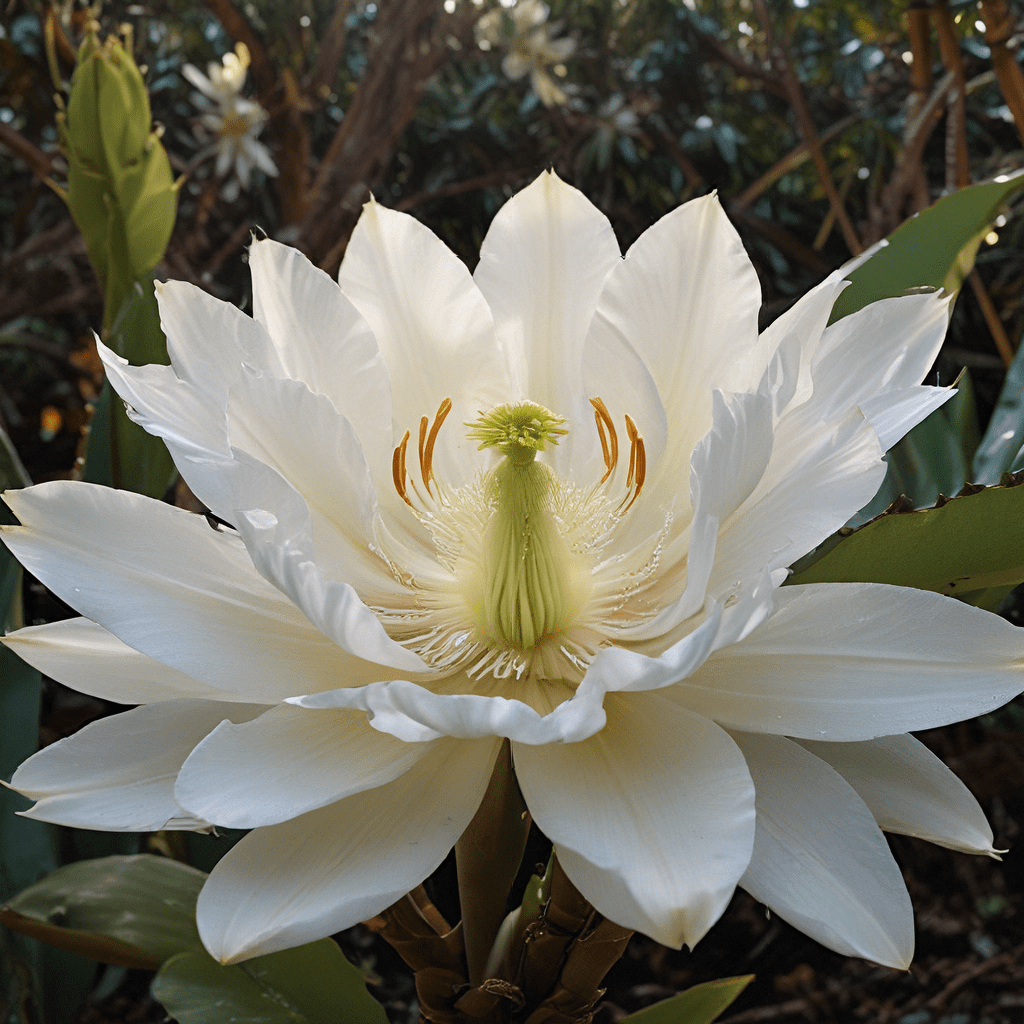The Night-Blooming Cereus: A Symbol of Ephemeral Beauty
In the lush, tropical landscape of Hawaii, a captivating plant unfolds its beauty under the cloak of night. The night-blooming cereus, or Cereus grandiflorus, is a fascinating cactus known for its breathtaking, ephemeral blooms. These flowers, with their mesmerizing fragrance and delicate beauty, open for a single night, adding a touch of magic to the Hawaiian night.
The cereus is more than just a beautiful flower. In Hawaiian mythology, it holds a special place as a symbol of fleeting beauty, the cycle of life and death, and the interconnectedness of the natural world.
The cereus's transient nature makes it a powerful metaphor for the impermanence of life. Its fleeting blooms, lasting just a single night, remind us that beauty is often fleeting, just like our own lives.
The Legend of Hiʻiaka and the Cereus
One of the most famous stories involving the night-blooming cereus in Hawaiian folklore is the tale of Hiʻiaka, the younger sister of the volcanic goddess Pele. Hiʻiaka, a powerful sorceress, was tasked with retrieving a lover for Pele, the handsome demigod Lohiʻau.
As Hiʻiaka journeyed across the islands, she encountered many challenges and obstacles. One night, as she rested in a secluded grove, she was captivated by the breathtaking beauty of the night-blooming cereus. The flower, with its luminous white petals and intoxicating fragrance, reminded her of Lohiʻau.
The cereus, in this legend, represents Hiʻiaka's unwavering determination and her longing for Lohiʻau. It also symbolizes the ephemeral nature of love, as the flower blooms only for a single night.
The Cereus as a Bridge Between Worlds
In Hawaiian mythology, the cereus is often associated with the realm of the spirits. Its nocturnal bloom is seen as a bridge between the world of the living and the world of the dead. The flower, opening under the light of the moon, is believed to be a portal through which spirits can travel.
The cereus's nocturnal habit further supports this belief. The plant, dormant during the day, awakes at night, becoming a symbol of the hidden and unseen realms.
The Night-Blooming Cereus: A Metaphor for Life and Death
The night-blooming cereus's fleeting beauty is often linked to the cycle of life and death in Hawaiian mythology. Its bloom, lasting only a single night, reflects the transience of life, while its eventual withering signifies death. This cyclical nature is reflected in many Hawaiian beliefs, which emphasize the interconnectedness of life and death.
The cereus, in its brief yet intense beauty, serves as a reminder of the preciousness of life and the inevitability of death. It teaches us to appreciate the present moment and to embrace the cycle of life.
The Cereus and the Hawaiian Concept of Mana
Mana, a powerful concept in Hawaiian culture, refers to the spiritual energy that permeates all things. The night-blooming cereus, with its unique nocturnal bloom, is believed to hold a significant amount of mana. Its ability to transform from a seemingly dormant plant to a magnificent flower in a single night is seen as an expression of mana, the divine energy that transcends the physical world.
The cereus's mana is often invoked in rituals and ceremonies, as its presence is believed to enhance the power of prayers and offerings. The flower is also used for its medicinal properties, as it is thought to possess healing powers.
The Cereus in Hawaiian Folklore: Stories and Tales
Beyond the legend of Hiʻiaka, the night-blooming cereus weaves its way into many Hawaiian stories and tales. These stories often highlight the plant's mysterious nature and its association with the supernatural.
One popular tale speaks of a young woman who fell in love with a spirit who lived in the forest. The spirit, appearing only at night, gifted her with a night-blooming cereus as a token of his love. Every night, the woman would watch the flower bloom, remembering her lover.
Another story tells of a wise old woman who used the cereus's petals to create a powerful potion that could heal the sick and injured. It was said that the flower's fragrance possessed a healing energy, and its nectar could alleviate pain and suffering.
These stories showcase the rich cultural significance of the night-blooming cereus in Hawaiian folklore. It's a symbol of love, loss, mystery, and healing, reminding us of the deep connection between humans and the natural world.
Scientific Theories of the Cereus’s Night-Blooming Habit
While Hawaiian mythology provides enchanting explanations for the cereus's nocturnal behavior, science offers a more pragmatic perspective. The nocturnal blooming of this cactus is primarily driven by its unique adaptation to its environment.
The cereus's fragrant flowers attract night-flying moths, which are the primary pollinators for this plant. By opening its flowers in the cool, humid nights, the cereus maximizes the presence of these moths, ensuring successful pollination.
Another factor influencing its night-blooming habit is the avoidance of intense sunlight. The cereus's delicate flowers are highly susceptible to the sun's rays, which can damage their delicate petals. By blooming at night, the plant protects its flowers from the sun's harshness.
The Role of the Moon in the Cereus’s Bloom
The moon, with its gentle light and celestial influence, plays a fascinating role in the cereus's blooming cycle. While the moon doesn't directly trigger the flower's opening, it provides an ideal environment for the cereus to flourish.
The moon's soft light allows the moths to effectively locate the fragrant flowers, aiding pollination. Additionally, the cooler temperatures under a moonlit sky help preserve the delicate petals for a longer duration.
The night-blooming cereus, therefore, embodies the delicate dance between nature's rhythms and the celestial influences that shape our world.
The Cereus and the Hawaiian Calendar
The night-blooming cereus, with its predictable blooming cycle, has been woven into the fabric of the Hawaiian calendar. The plant's appearance served as a natural marker for specific seasons and events, guiding the daily lives of the people.
For example, the first bloom of the cereus in the spring marked the beginning of the planting season, while its full bloom in the summer signified the onset of the harvest. The cereus's cyclical appearance also guided the timing of rituals and ceremonies, offering a natural connection to the yearly rhythm of life.
The Enduring Legacy of the Cereus in Hawaiian Culture
The night-blooming cereus continues to hold a special place in Hawaiian culture, its enduring legacy evident in contemporary art, literature, and music. The plant's ephemeral beauty and symbolic significance continue to inspire artists, writers, and musicians, ensuring that its story remains an integral part of Hawaiian heritage.
From traditional Hawaiian chants and songs to contemporary art installations and literary works, the night-blooming cereus has become a powerful symbol of the island's culture, representing beauty, mystery, and the interconnectedness of life, death, and the natural world.
FAQ
Q: What is the scientific name of the night-blooming cereus?
A: The scientific name of the night-blooming cereus is Cereus grandiflorus.
Q: Why is the night-blooming cereus considered a symbol of fleeting beauty?
A: Its flowers only bloom for a single night, reminding us of the impermanence of life and beauty.
Q: How does the night-blooming cereus connect to Hawaiian mythology?
A: It features prominently in stories, often symbolizing love, loss, mystery, and the connection between the physical and spiritual worlds.
Q: What is the significance of the moon in the night-blooming cereus's bloom?
A: The moon's soft light and cooler temperatures create an ideal environment for the cereus to bloom and attract its pollinators.
Q: How has the night-blooming cereus influenced Hawaiian culture?
A: It's a symbol of beauty, mystery, and the interconnectedness of life, death, and the natural world. Its cyclical bloom has shaped the Hawaiian calendar and continues to inspire contemporary art, literature, and music.



